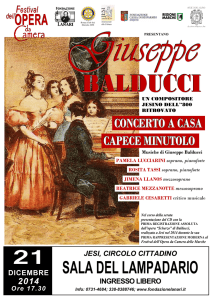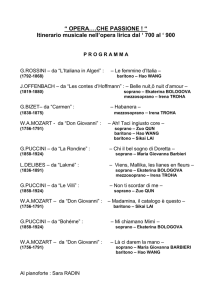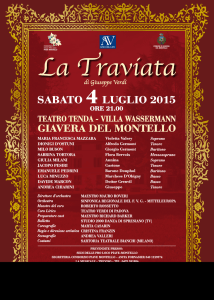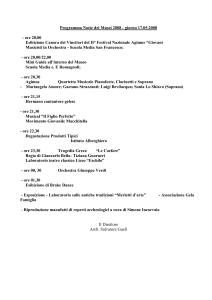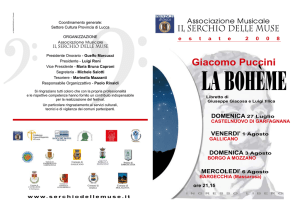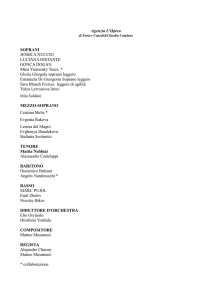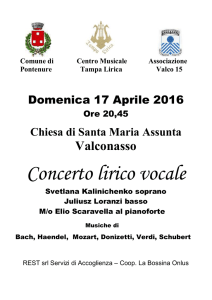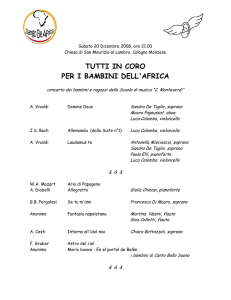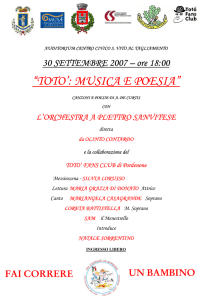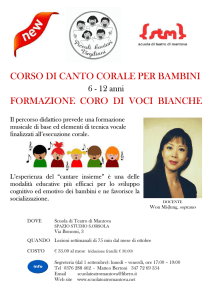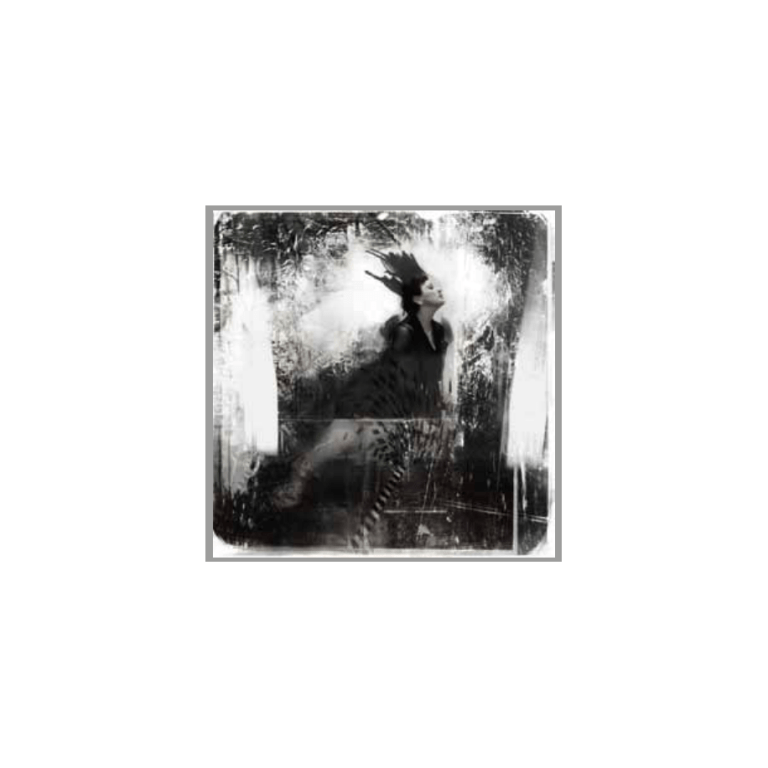
Collana a cura di Enrica Dorna
Michele Liuzzi
Daguerréotypes
Progetto grafico / Graphics project: Franco Mello
Impaginazione grafica / Graphics lay out: Barbara Fistrali
Foto originali / Original photographic shots: Edoardo Piva
Stampa / Print: Arti Grafiche Parini
Traduzioni / Translations: Leonie Heys Cerchio
© 2012 coup d’idée
Michele Liuzzi per le opere
Foto di copertina / Cover photograph:
Adriana Lecouvreur, 2009 - soprano - Micaela Carosi
Introduzione di Alberto Mattioli
con un testo di Sylvano Bussotti
All’opera ci possono essere molti momenti magici. I più magici sono quelli in cui si passa
dalla realtà alla finzione che poi, per il misterioso potere del teatro, finisce spesso per essere
più vera del vero. Per lo spettatore, è il momento in cui in sala le luci si spengono; per
l’interprete, quello in cui entra in scena: un passo, un gesto, una nota e il signor Alipio
Forconi musico, per battezzarlo come Benedetto Marcello nel Teatro alla moda, si trasfigura,
cambia, diventa altro da sé. Non importa se nella vita reale sia un bello o brutto, romantico o
no, simpatico o divo (ma in ogni caso quasi sempre provvisto di un ego anormalmente ampio,
come la voce: non è un mestiere per timidi). Non sempre una grande personalità in scena si
rivela tale anche nella vita, e alla fine non ci importa nemmeno. Per lo spazio di due o tre
ore, anche di più per un barocco integrale, un Grand Opéra o un Wagner, infilato in quel
grande microonde dell’emozione che è l’opera perfino il più detestabile dei panzoni diventerà
infallibilmente il nostro eroe. Strumento della genialità di qualcuno di più grande di lui, dei
Monteverdi, dei Mozart, dei Rossini, dei Verdi, degli Janaček, “dirà” quello che noi spettatori,
poveri operoinomani drogati di melodramma, sentiamo ma non riusciamo a esprimere.
Queste foto di Michele Liuzzi, raffinate tenere ironiche, insomma bellissime, raccontano
appunto la straordinaria metamorfosi che è l’opera per chi la canta (e che, se la canta bene,
diventa emozione e commozione e catarsi anche per chi l’ascolta). I suoi protagonisti sono,
in realtà, uni e trini. C’è in primo luogo il cantante, il signor José Cura o la signora Barbara
Frittoli, con la sua identità, la sua faccia, la sua personalità, la sua storia. E, in certi casi,
vedi Anja Silja qui ritratta come Contessa della Pikovaja Dama, che storia. Poi c’è il suo
personaggio, che non è “la Violetta di Verdi” o l’“Isotta di Wagner” come credono le anime
semplici, ma qualcosa di molto complesso, in cui entrano certo un libretto e una partitura ma
anche la storia interpretativa, la tradizione e l’innovazione, il passato e il presente, il rapporto
con il direttore, il regista, gli altri cantanti. E infine c’è la sintesi, il risultato dell’incontro del
cantante con il personaggio, che fa dell’uno e dell’altro, ogni volta, qualcosa di diverso e di
nuovo, cioè la perenne, incantata meraviglia di questo strano spettacolo che è l’opera lirica.
“Fissare” in un clic questa metamorfosi non è né facile né consueto. Perciò si è molto felici
che queste fotografie esistano.
There can be many magical moments at the Opera. The most magical are the ones that pass from
reality to fiction, which then, because of the mysterious power of the theatre, often end up being
more real than reality. For the audience, it is the moment when the lights turn down; for the
interpreters, when when they enter the scene: with a step, a gesture, or a note. And musician Mr
Alipio Forconi, in order to baptize it like Benedetto Marcello in Teatro alla moda (“The fashionable
theatre”), transfigures, changes and becomes something other than himself. It doesn’t matter if in
real life he is beautiful or ugly, romantic or otherwise, good natured or a star (in any case he is
almost always equipped with an abnormally large ego, as is his voice: it is not a profession for
people who are shy). Not always does a great personality on stage reveal to be the same also
in life, and in the end we don’t even care about this. For two or three hours, even longer for a
Baroque Opera in its integral form, a Grand Opéra or a Wagner piece, we are transfixed by the
great microwave of emotion which is the opera, and even the most despicable fatso will infallibly
become our hero. Instrument of the genius of someone greater than he is, such as a Monteverdi,
Mozart, Rossini, Verdi or Janaček, he will “say” what we spectators, poor Opera-maniacs drugged
by melodrama, feel but are not able to express ourselves.
These Photographs of Michele Liuzzi, fine, tender and ironic - in short - beautiful, represent exactly
the extraordinary metamorphosis that is the Opera for the one who sings (and that, if the person sings
well, becomes emotion and commotion and catharsis for those who listens). His protagonists are, in
reality, both one and three. In the first place there is the singer, Mr José Cura or Mrs Barbara Frittoli,
with his or her identity, face, personality and story. And, in some cases, you can see a singer like Anja
Silja portayed here as the Countess of the Pikovaja Dama, what a story. Then there is her character,
which isn’t “Verdi’s Violetta” or “Wagner’s Isotta” as simple souls believe, but something very
complex, in which a libretto and a score certainly take part, but also the interpreted story, tradition
and innovation, the past and the present, the relationship with the conductor, the director and the
other singers. And finally there is the synthesis, the result of the meeting between the singer and
the character, that makes of one and the other, every time, something different and new, that is the
perennial, enchanted marvel of this strange performance that Opera is. “To fix” this metamorphosis
in one shot is not easy and is very unusual. That’s why we are very happy that these photographs exist.
Alberto Mattioli
Alberto Mattioli
PLATES
01
PLATES
02
PLATES
03
PLATES
04
PLATES
05
PLATES
06
PLATES
07
PLATES
08
PLATES
09
PLATES
10
PLATES
11
PLATES
12
PLATES
13
PLATES
14
PLATES
15
PLATES
16
PLATES
17
PLATES
18
PLATES
19
PLATES
20
PLATES
21
PLATES
22
PLATES
23
PLATES
24
PLATES
25
PLATES
26
PLATES
27
PLATES
28
PLATES
29
PLATES
30
PLATES
31
PLATES
32
PLATES
33
PLATES
34
PLATES
35
PLATES
36
Il Maestro giunge in spiaggia, al termine di una mattinata trascorsa scrivendo musica. Colmo
della calura, brevissima visita di cortesie; lo troviamo vestito di tutto punto nell’agosto
infuocato.
L’adolescente, discepolo eccitato dal privilegio di potersi presentare al nume.
Il mare, protagonista dell’Opera ULISSE, alla riva ornata di umili oggetti consueti e squillante
delle risa gioiose di bimbi.
Partiture di Mozart o di Verdi, ma anche TABARRO di Puccini e, appunto, di Dallapiccola,
VOLO DI NOTTE.
Lampi accecanti nelle più fitte tenebre scolpiscono le figure dei protagonisti con musiche
indimenticate.
Il palcoscenico è quello del Regio torinese, già tecnologica scena, capace di riunirvi stupefacenti masse corali nelle luci e ombre dello stile, condurre l’accento dei protagonisti all’apice
armonico del suono Storico.
The Maestro reaches the beach, at the end of an entire morning spent writing music. Saturated
with the heat, a very short courtesy visit; we find him all dressed up in fiery August.
The teenager, the disciple excited by the privilege of being able to present himself to his numen.
The sea, protagonist of the ULISSE Opera, embellished at the shore by humble every-day objects
and shrill with the joyful laughter of children.
Scores by Mozart or Verdi, but also TABARRO by Puccini and, in fact, by Dallapiccola, NIGHT
FLIGHT.
Blinding lightning sculpts the figures of the protagonists out of the deepest darkness to
unforgettable music.
The stage is the one of the Regio theatre in Turin, already a technological setting, which is
capable of gathering astonishing choral masses within the lights and shadows of its stile,
conducting the accent of the protagonists to the harmonic apex of historical sound.
PHAIDRA / HELIOGABALUS che dalla storia entrano nel mito e sembrano provenire dalla
leggenda medesima.
Una regina che l’umanissimo segreto di un amore colpevole condusse a morte.
Un imperatore incoronato a quattordici anni assassinato a diciotto, tanto che lo si dovette
definire anarchico incoronato.
L’incontro delle due figure può vaneggiarsi nella cupa scenografia di sonorità immote, esplose
fra gli estremi sensibili del gesto sovracuto e del grave, tenebroso ritmo di passi lacerati nelle
armonie insostenibili spinte al futuro dell’invenzione.
Reso omaggio al senso più antico del termine ACCADEMIA.
Simboleggiare, rappresentare una impossibile identità nel segno anche grottesco, che specchi
politi o deformati fanno ingigantire da luci razionali le armonie fondanti il fascino teatrale, la
sua ricchissima teoria di progresso.
Ad ogni recita risoluzione di tutti gli accenti, offertorio, lamento, estatico gesto del Bello.
Così mi piace rammentare il mio TEATRO REGIO.
PHAIDRA / HELIOGABALUS which from history became myths and seem to derive from the
same legend.
The extreme human secret of a guilty love that led a queen to death.
An emperor crowned at fourteen years old and murdered at eighteen, so that he had to be
defined a crowned anarchist.
The meeting of the two characters can wander in the obscure scenery of motionless resonance,
that explodes between the sensitive extremes of the high-pitched gesture and the solemn, dark
rhythm of lacerated steps in the unsustainable harmony that is pushed towards the future of
invention.
A tribute to the most ancient meaning of the term ACADEMY.
To symbolize, represent an impossible identity in the even grotesque sign, that polished or
deformed mirrors enlarge, with rational lights, the harmony which founds theatrical charm,
its extremely rich theory of progress. Every recital is a resolution of all accents, an offertory, a
lament, and an ecstatic gesture of Beauty.
This is how I like to recall my TEATRO REGIO.
Sylvano Bussotti
Sylvano Bussotti
Michele Liuzzi (1970) vive e lavora a Torino.
Proviene da studi sul fumetto e da una pluriennale esperienza in ambito teatrale.
Il suo lavoro si articola in una serie di progetti che vanno dalla pittura, al disegno, alle
elaborazioni digitali. L’ispirazione al teatro è sempre presente, così come l’attrazione per il
mondo del fumetto e le ricercate atmosfere del primo novecento.
Michele Liuzzi (born 1970) lives and works in Turin.
He started with comics studies and has many years’ experience in the theatre environment. His
work has branched out into a series of different projects, that go from painting to drawing and
digital processing. The theatre is a constant inspiration for him, as the world of comics is and
refined atmospheres taken from the beginning of the Twentieth Century are.
Daguerréotypes
Daguerréotypes
Come termine evocativo di un’immagine impressa su una lastra ai sali d’argento còlta nella
sua casualità, con le sue imperfezioni, lo sporco, gli ossidi del metallo.
L’impressione di un’immagine scolpita, rivestita da quell’albume vitreo della moderna carta
fotografica.
Il corpo è frugato, indagato, manipolato, alterato, computerizzato, percorso da flussi di energie
e pulsioni che, tesi all’unisono, ricostruiscono l’atteggiamento iniziale che ha ispirato la
posa. Mi piace immedesimarmi in quella porzione di luce che entra dirompente nella scatola
magica e, catturata dalla lastra, ne genera il ritratto.
Used as an evocative term as if the image was still imprinted on a silver plate with the fortuity
and imperfections of the dirt of metal oxides.
The imprint of a sculpted image coated with that vitreous glair of modern photographic paper.
The body is searched, investigated, manipulated, altered, computerized, taken over by a flux of
energy and beats which, taut in unison, recreate the initial attitude that inspired the pose. I like
to identify myself with that portion of light that abruptly enters the magic box and, captured by
the plate itself, generates the portrait.
Plates
01
02
03
04
05
06
07
08
09
10
11
12
13
14
15
16
17
18
19
20
21
22
23
24
25
26
27
28
29
30
31
32
33
34
35
36
Donna Lucrezia Borgia, 2008 - soprano - Dimitra Theodossiou
Luisa, 2010 - soprano - Fiorenza Cedolins
Peter Grimes, 2010 - tenore - Neil Shicoff
Ilia, 2010 - soprano - Annick Massis
Erodiade, 2008 - mezzosoprano - Graciela Araya
Taddeo, 2009 - basso - Roberto de Candia
Norina, 2009 - soprano - Serena Gamberoni
Ernesto, 2009 - tenore - Francesco Meli
Erode Antipa, 2008 - tenore - Peter Bronder
La principessa di Bouillon, 2009 - mezzosoprano - Marianne Cornetti
Argirio, 2009 - tenore - Antonino Siragusa
Tancredi, 2009 - contralto - Daniela Barcellona
Salome, 2008 - soprano - Nicola Beller Carbone
Gennaro, 2008 - tenore - José Bros
La contessa, 2009 - mezzosoprano - Anja Silja
Crobyle, 2008 - soprano - Eleonora Buratto
Creonte, 2007 - baritono - Lucio Gallo
Edgar, 2008 - tenore - José Cura
Giorgio Germont, 2009 - baritono - Carlos Álvarez
Idamante, 2010 - soprano - Ruxandra Donose
Elvira, 2007 - soprano - Maria Alessandra Rezza
Polina, 2009 - mezzosoprano - Julia Gertseva
Lindorf, Coppélius, Dr. Miracle e Dapertutto, 2008 - basso - Alfonso Antoniozzi
Isabella, 2009 - contralto - Vivica Genaux
Tito Vespasiano, 2008 - tenore - Giuseppe Filianoti
Olympia, 2009 - soprano - Desirée Rancatore
Amenaide, 2009 - soprano - Patrizia Ciofi
Mustafà, 2009 - basso - Lorenzo Regazzo
Maurizio, 2009 - tenore - Marcelo Álvarez
Liza, 2009 - soprano - Svetla Vassileva
Tigrana, 2008 - mezzosoprano - Giuseppina Piunti
Don Pasquale, 2009 - basso - Roberto Scandiuzzi
Don Alfonso, 2008 - basso - Michele Pertusi
Maffio Orsini, 2008 - contralto - Kate Aldrich
Idomeneo, 2010 - tenore - Matthew Polenzani
Thaïs, 2008 - soprano - Barbara Frittoli

